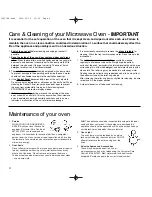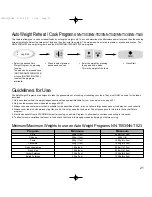
10
DISH SIZE
Follow the dish sizes given in the
recipes, as these affect the
cooking and reheating times. A
quantity of food spread in a
bigger dish cooks and reheats
more quickly.
QUANTITY
Small quantities cook faster than
large quantities, also small
meals will reheat more quickly
than large portions.
SPACING
Foods cook more quickly and
evenly if spaced apart. NEVER
pile foods on top of each other.
SHAPE
Even shapes cook evenly. Food
cooks better by microwave when
in a round container rather than
square.
DENSITY
Porous airy foods heat more
quickly than dense heavy foods.
COVERING
Cover foods with microwave cling
film or a self-fitting lid. Cover fish,
vegetables, casseroles, soups. Do
not cover cakes, sauces, jacket
potatoes, pastry items.
ARRANGING
Individual foods e.g. chicken
portions or chops, should be
placed on a dish so that the
thicker parts are to the outside.
STARTING TEMPERATURE
The colder the food, the longer it
takes to heat up. Food from a
fridge takes longer to reheat
than food at room temperature.
TURNING AND STIRRING
Some foods require stirring
during cooking. Meat and poultry
should be turned after half the
cooking time.
LIQUIDS
All liquids must be stirred before
and during heating. Water
especially must be stirred before
and during heating, to avoid
eruption. Do not heat liquids that
have previously been boiled. DO
NOT OVERHEAT.
CHECKING FOOD
It is essential that food is checked
during and after a recommended
cooking time, even if an AUTO
PROGRAM has been used (just
as you would check food cooked
in a conventional oven). Return
the food to the oven for further
cooking if necessary.
CLEANING
As microwaves work on food
particles, keep your oven clean at
all times. Stubborn spots of food
can be removed by using a
branded microwave spray cleaner,
sprayed onto a soft cloth, always
wipe the oven dry after cleaning.
F00035Q31BP 2005.02.01 17:57 Page 10













































